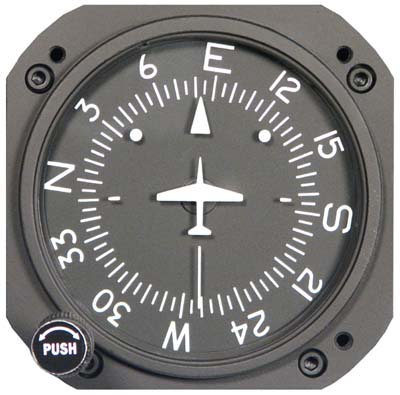Before: This is a Beechcraft Bonanza similar to the one chartered for the flight from Mason City, Iowa, to Fargo, North Dakota.
After: These photos of the crash appeared in the Mason City Register:


Compounding the pilot's difficulties, what instrument training he had received was in an airplane with a different instrument from the one he flew that fateful night. Known as the Attitude Indicator, a more familiar term for it is the Artificial Horizon. This instrument uses gyroscope to drive a display that shows the pilot the airplane's orientation relative to the horizon, and therefore the ground. From it, a pilot can see when the plane's wings are level, or parallel to the horizon, as well as whether the nose is above, level with, or below the horizon. The artificial horizon that the pilot trained with looked like this:
This
instrument is similar to the one installed in the accident airplane.
While it provides the same information to the pilot, it requires more
concentration to interpret the display:
This is what a modern Attitude Indicator looks like. The blue and brown represent the sky and ground, respectively. The airplane is represented by the orange line in the center of the instrument.

The Directional Gyro installed in the plane would have looked similar to this one. The Directional Gyro, or DG, is a gyro-stabilized mimic of a magnetic compass. I say 'mimic' because while it presents the same information as a compass, the DG has no ability to sense north the way a compass does; instead the pilot must set the DG to match the compass before departure, and while in flight must periodically cross-check the DG against the compass and, if necessary, adjust the DG to match the compass. This style of DG, like the Artificial Horizon just above, requires the pilot to have a clear mental image of the airplane's position in space. One difficulty is that the pilot must turn away from a desired heading in order to reach it. For example, this instrument is indicating a heading of 325 degrees, which is basically northwest. If the pilot wanted to turn to the north, a heading of 360 degrees, he would need to make a right turn, although it appears to the left on this instrument. Many airplanes have magnetic compasses that indicate in a similar manner.

This is a modern-day Directional Gyro, which is so much easier to use that it really isn't funny. In the case of the crash it really didn't matter though, because the investigators found that the DG in the Bonanza had been caged. That means that the gyro had been locked and the instrument was not operating, thus providing no useful information - assuming that the pilot realized that this was the case.
As is often the case, this crash was the end result of a series of unfortunate events. Had the heater in the tour bus not been acting up, or had the laundromat in Clear Lake, Iowa, been open that day; if the pilot been told about the worsening weather, or had the flight been made in an aircraft equipped with a different gyro and/or a working autopilot and/or a more experienced pilot, or if they had just waited until the next morning, this story probably would have a different ending.
References:NPR's Morning Edition
The CAB Report
AOPA article









Well I hope the security screen is actually going ti let me write something.
ReplyDeleteI had asked Roger years ago about the song "The Day The Music Died" it being clear to me that it referred to some event. He didn't know the answer, but I learned the history later - perhaps on NPR, but no one has ever provided the background before - really interesting.
Now about that Sports Fans post: will they let just anyone paint an airplane?
N